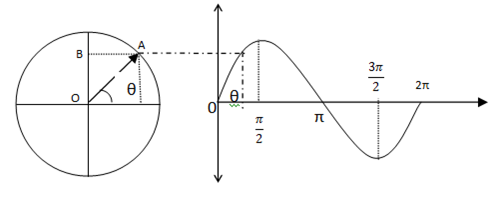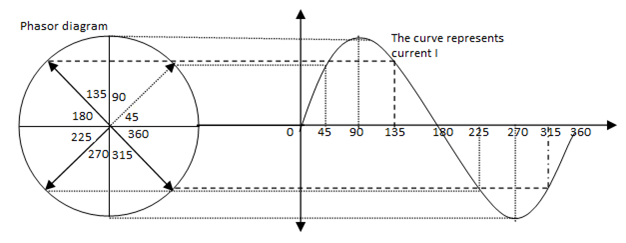Question 10: What do you mean by phasor diagram? Why we use it for a sinusoidal current and voltage?
ANSWER
Phasor
Phasor is the vector representing an alternating quantity and rotates in the anti-clockwise direction with constant angular velocity ω about a fixed point.
It should be noted that,
- Length of the phasor is equal to the maximum value of the alternating quantity.
- The angle of the phasor with the positive x-axis indicates the phase of the alternating quantity.
- Angular velocity of the phasor is equal to the angular velocity of the alternating quantity.
- It is at the horizontal position at the instant when the value of the alternating quantity is zero and increasing in the positive direction.
- A phasor diagram can be used for addition and subtraction of the alternating quantities.
AC circuit current and voltage are sinusoidal and mathematical equation for such a function is
I = Imsinωt
Consider the figure below.

OA represents the maximum value of the current (taken on a scale like any vector quantity). This is called phasor. Let OA is horizontal at some instant of time and rotating in the anti-clockwise direction with a constant angular velocity ω. After time t, it rotates through an angle θ. Let at this moment its projection on the y-axis is OB. Then, OB = OA sin θ. Since projection of OA on the y-axis is current, therefore,
I = Imsinωt
Here OA =Im, I = instantaneous current, θ = ωt.
As the current increases, the phase angle with x-axis also increases and the current reaches its maximum value Im when the phasor angle is 900 and the projection on y-axis is also maximum. Then the current reverses its direction and slowly decreases and so do the phasor projection on y-axis. This is shown in the figure below.

However, if the current and voltage are out of phase by an angle φ, for example voltage leads the current, both quantities can be represented on the same phasor diagram. This is because the velocity ω is same for both quantities and the phase difference φ is constant.

Pingback:lq-ch-15-p12 – msa